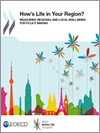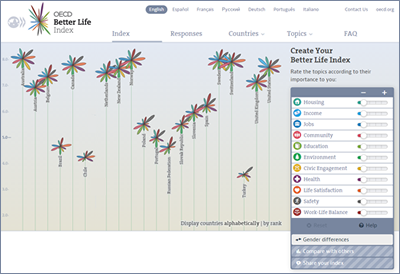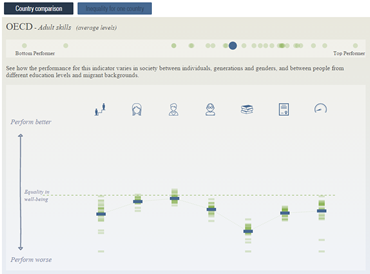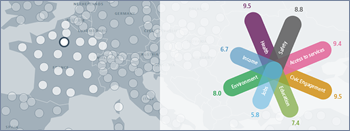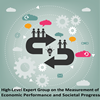Centre on Well-being, Inclusion, Sustainability and Equal Opportunity (WISE)
Better Life Initiative: Measuring Well-Being and Progress
Are our lives getting better? How can policies improve our lives? Are we measuring the right things? The OECD Better Life Initiative and the work programme on Measuring Well-Being and Progress answer these questions. They allow understanding what drives well-being of people and nations and what needs to be done to achieve greater progress for all.
Well-being research
For many years, focusing on people's well-being and societal progress, the OECD has been looking not only at the functioning of the economic system but also at the diverse experiences and living conditions of people and households. Measuring well-being and progress is a key priority that the OECD is pursuing as part of the Better Life Initiative through various streams of research and on-going work. The OECD is pursuing an ambitious agenda with the aim to develop better well-being metrics, and is also providing analysis in order to bridge the gap between existing well-being metrics and policy intervention.
- Find out more about well-being research and ongoing work
COVID-19 and Well-being
The report explores the immediate implications of the pandemic for people’s lives and livelihoods in OECD countries. It charts the course of well-being – from jobs and incomes through to social connections, health, work-life balance, safety and more – using data collected during the first 12-15 months of the pandemic. It also takes stock of what has happened to human, economic, social and natural capital that, beyond their effects on people’s lives today, shape living conditions for years to come. It shows how COVID-19 has had far-reaching consequences for how we live, work and connect with one another, and how experiences of the pandemic varied widely, depending on whether and where people work, their gender, age, race and ethnicity, education and income levels. The report also examines the role that well-being evidence can play in supporting governments’ pandemic recovery efforts. It argues that a well-being lens can prompt policy-makers to refocus on the outcomes that matter the most to people, to redesign policy content from a more multidimensional perspective, to realign policy practice across government silos, and to reconnect people with the public institutions that serve them.
How's Life?
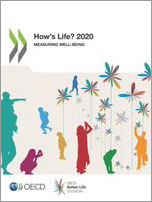 How's Life? 2020: Measuring Well-being charts whether life is getting better for people in 37 OECD countries and 4 partner countries. This fifth edition presents the latest evidence from an updated set of over 80 indicators, covering current well-being outcomes, inequalities, and resources for future well-being. Since 2010, people’s well-being has improved in many respects, but progress has been slow or deteriorated in others, including how people connect with each other and their government. Large gaps by gender, age and education persist across most well-being outcomes. Generally, OECD countries that do better on average also feature greater equality between population groups and fewer people living in deprivation. Many OECD countries with poorer well-being in 2010 have since experienced the greatest gains. However, advances in current well-being have not always been matched by improvements in the resources that sustain well-being over time, with warning signs emerging across natural, human, economic and social capital.
How's Life? 2020: Measuring Well-being charts whether life is getting better for people in 37 OECD countries and 4 partner countries. This fifth edition presents the latest evidence from an updated set of over 80 indicators, covering current well-being outcomes, inequalities, and resources for future well-being. Since 2010, people’s well-being has improved in many respects, but progress has been slow or deteriorated in others, including how people connect with each other and their government. Large gaps by gender, age and education persist across most well-being outcomes. Generally, OECD countries that do better on average also feature greater equality between population groups and fewer people living in deprivation. Many OECD countries with poorer well-being in 2010 have since experienced the greatest gains. However, advances in current well-being have not always been matched by improvements in the resources that sustain well-being over time, with warning signs emerging across natural, human, economic and social capital.
Beyond an overall analysis of well-being trends since 2010, this report explores in detail the 15 dimensions of the OECD Better Life Initiative, including health, subjective well-being, social connections, natural capital, and more, and looks at each country’s performance in dedicated country profiles.
How's Life? series
|
|
|
Playing with the data
Create your Better Life Index
|
Are all OECD countries equally unequal? Inequalities in well-being
|
Create your Regional Well-Being Index
|
How has quality of life evolved since 1820? |
Events
The OECD is continuing the dialogue on well-being through various events including the OECD World Forums on Statistics, Knowledge and Policy. On 27-29 November 2018, the OECD and Statistics Korea co-organised the 6th OECD World Forum on Statistics, Knowledge and Policy in Incheon, Korea.
Related initiatives
|
|
Contact us: [email protected]
Related Documents


